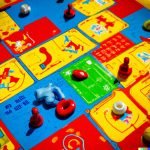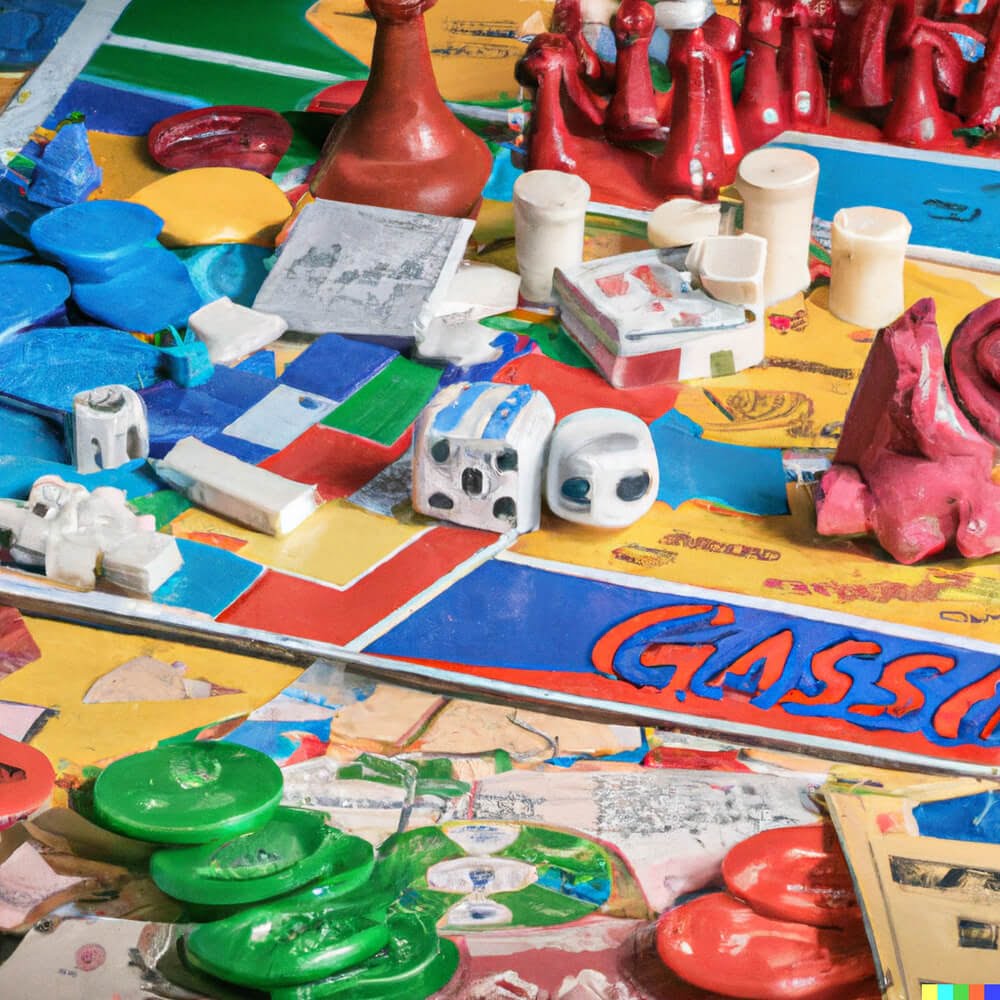The Blokus board game has captivated players around the world with its unique gameplay and strategic challenges. Designed for 2-4 players, this abstract strategy game requires participants to strategically place their colored pieces on a grid-like board to maximize their territory while blocking opponents. With its simple rules and infinite possibilities, it’s no wonder why Blokus has gained popularity in the gaming community.
In this article, we will delve into the world of Blokus strategy, providing you with valuable insights and techniques to up your game. Starting with understanding the basics of the game, we will break down the rules and objectives, as well as explain the different types of pieces and their restrictions.
After grasping the essentials, we will dive into starting strategies that can give you an edge right from the beginning. Learn how to secure corners and edges early on to establish a strong position on the board. We’ll also explore offensive tactics that involve blocking opponents and limiting their possible moves. Whether it’s creating barriers or cutting off opponents’ access to crucial areas, these aggressive strategies can put you in a dominant position.
But great defense is just as important as offense. We’ll guide you through defensive approaches that focus on protecting your own pieces and preventing being boxed in by opponents. From building walls to establishing secure positions, learn how strategic placement can shape your defenses.
As we progress further in this guide, we’ll tackle advanced techniques that can help elevate your gameplay even more. Discover concepts such as sacrificing pieces for future advantage and planning ahead to gain a competitive edge over your rivals. Analyzing opponents’ moves becomes key at this stage – adapting your strategies based on their intentions and predicting their next moves will be vital for success.
Finally, we’ll discuss fine-tuning your playstyle – honing in on what works best for you through experimentation and practice. Your experience will help shape a personal approach to the game, allowing you to strategize and adapt with confidence.
So get ready to dive into the exciting world of Blokus strategy. Armed with these tips and techniques, you’ll be able to maximize your territory and outsmart your opponents on every turn. Don’t miss out on the opportunity to become a Blokus master – let’s begin.
Understanding the Basics
In order to develop effective strategies for playing the Blokus board game, it is crucial to have a solid understanding of the game’s rules and objectives. Blokus is a strategy game that can be played by two to four players, with each player aiming to place as many of their colored pieces on the board as possible.
The game board consists of a grid with 20×20 squares, and each player starts with a set of uniquely shaped pieces in their chosen color. The objective of the game is to strategically place these pieces on the board, ensuring that each piece touches at least one other piece of the same color only at its corners.
There are several important rules and restrictions to keep in mind when placing pieces in Blokus. First, players must always start from one of the four corners of the board. Additionally, players can only place their pieces so that they touch a corner or an edge of any already placed piece of their own color.
Understanding these basic rules will help players make informed decisions about where to position their pieces on the board. It is important to note that efficiency in using space is key in Blokus – occupying more squares will limit opponents’ options while providing more space for future moves.
| Rule | Description |
|---|---|
| Starting Position | Players must start from one of the four corners. |
| Piece Placement | Pieces must touch a corner or an edge of any already placed piece of their own color. |
By familiarizing themselves with these foundational aspects of Blokus gameplay, players will be well-prepared to begin developing effective strategies for placement and movement.
Starting Strategies
When it comes to the Blokus board game, how you start can greatly impact your overall gameplay and chances of success. Here are some starting strategies to consider:
- Secure Corners and Edges: One important starting strategy is to focus on securing corners and edges early on in the game. This allows you to establish a strong position on the board while limiting your opponents’ options for expansion. By placing your pieces strategically near these areas, you can block off potential routes for other players, making it harder for them to expand their territories.
- Build Towards the Center: Another effective starting strategy is to gradually build towards the center of the board. This approach allows you to create a solid foundation while leaving room for future growth and maneuverability. By extending your territory towards the center, you’ll have more opportunities for complex maneuvers and expansion later in the game.
- Balance Defense with Offense: While it’s crucial to focus on securing your own pieces and positions during the early stages of the game, it’s equally important not to neglect offensive tactics. Strive for a balance between defense and offense, as being too passive may allow opponents to dominate the board while being too aggressive might leave you vulnerable.
To implement these strategies effectively, consider the order in which you place your pieces. Start with larger pieces that can cover more ground or separate opponents’ territories. Then gradually switch to smaller pieces as space becomes limited or when aiming to achieve specific strategic purposes.
By following these starting strategies, players can set themselves up for success by establishing a strong foundation while limiting their opponents’ options early on in the Blokus board game. Remember that practice makes perfect; experimenting with different approaches will help players find their personal playstyle that works best for them.
Offensive Tactics
When playing the Blokus board game, offensive tactics can play a crucial role in securing victory. By implementing aggressive strategies, players can block their opponents and limit their possible moves, gaining an advantage on the board. There are several offensive tactics that players can employ to increase their chances of success.
One effective offensive tactic is to create barriers on the board. By strategically placing pieces in a way that blocks off certain areas, players can limit their opponents’ access to those regions. This forces opponents to find alternative routes or make suboptimal moves, giving the player an opportunity to gain an upper hand.
Another offensive tactic is cutting off opponents’ access to the board. By carefully observing and predicting opponent movements, players can strategically place their own pieces to prevent others from expanding and reaching new territories. This not only limits their opponent’s options but also allows the player to secure more space for themselves.
| Offensive Tactic | Description |
|---|---|
| Create Barriers | Strategically placing pieces to block off areas and restrict opponent movement. |
| Cut Off Opponent Access | Predicting opponent movements and strategically placing pieces to prevent them from expanding. |
By understanding and implementing these offensive tactics effectively, players can greatly improve their chances of success in Blokus. It is important to constantly observe the board and analyze opponents’ moves in order to adapt strategies accordingly. Proactively blocking opponents while maintaining one’s own position is key in achieving victory.
In the next section, we will delve into defensive approaches which focus on protecting one’s own pieces and preventing being blocked in by opponents. These defensive strategies work in tandem with offensive tactics to create a well-rounded Blokus gameplay experience.
Defensive Approaches
When playing the Blokus board game, it’s not only important to focus on offensive strategies, but also to consider defensive approaches that can protect your own pieces and prevent being blocked in by opponents. By implementing defensive tactics, you can establish a strong position on the board and have more control over the game.
Building Walls
One effective defensive technique in Blokus is building walls. As you play your pieces, try to create a solid wall of your colors along the edges of the board. This helps create a barrier that opponents will have difficulty penetrating, giving you more room to expand and strategically maneuver your pieces without fear of getting blocked in.
Establishing Secure Positions
Another defensive approach is establishing secure positions on the board. Instead of placing all your pieces near the edges or corners, consider spreading them out across the middle of the board as well. This not only protects them from being cut off by opponents but also allows for better mobility and flexibility as the game progresses.
Protecting Against Blockades
As you strategize defensively, it’s important to anticipate and protect against potential blockades by opponents. Keep an eye on their moves and attempt to predict their future intentions. If you see them building up towards a certain area or attempting to cut off access to a part of the board, make sure you have alternative routes or backup plans in place to keep your pieces connected and avoid being trapped.
By implementing defensive approaches such as building walls, establishing secure positions, and protecting against blockades, you can increase your chances of success in Blokus. Remember that while offensive tactics are crucial for blocking your opponents’ moves and limiting their options, having a strong defense is equally important to protect your own pieces and maintain control over the board.
Advanced Techniques
In order to gain a competitive edge in the Blokus board game, players can utilize advanced strategies that go beyond the basic rules and starting techniques. These advanced techniques involve sacrificing pieces for future advantage and planning ahead to outmaneuver opponents. By employing these strategies, players can maximize their potential for success and improve their overall gameplay experience.
Sacrificing Pieces
One of the key concepts in advanced Blokus strategy is the idea of sacrificing pieces for future advantage. Sometimes, it may be necessary to make tactical sacrifices in order to set up a better position for future turns.
This could involve deliberately placing a piece in a suboptimal location or leaving gaps on the board early on, with the intention of capitalizing on those spaces later. By sacrificing certain moves now, players can create opportunities for larger and more strategic plays in subsequent turns.
Planning Ahead
Another essential element of advanced Blokus strategy is planning ahead. Rather than solely focusing on immediate moves, players should consider how each placement will impact their ability to make strategic plays later in the game. This involves analyzing potential future moves, considering possible responses from opponents, and evaluating different scenarios that may unfold. By envisioning various outcomes and anticipating opponents’ actions, players can make informed decisions that give them an advantage as the game progresses.
Utilizing Unique Piece Shapes
Advanced techniques also utilize the unique shapes of Blokus pieces to their advantage. Instead of simply placing pieces randomly or haphazardly, players should try to maximize their coverage on the board while minimizing restrictions for future moves.
This means strategically positioning pieces that have irregular shapes or angles so that they can be maneuvered more easily later on. By taking into account both current placement possibilities and how they align with future turns, players can optimize their use of each piece shape and increase their chances of success.
By incorporating these advanced techniques into their gameplay, Blokus players can elevate their strategies and become more competitive. Sacrificing pieces for future advantage, planning ahead, and utilizing the unique shapes of pieces are just a few examples of advanced techniques that can give players an edge in the game. However, it is important to note that practice and experience are crucial in mastering these strategies.
As with any tactical game, finding what works best for each individual player may require experimentation and adaptation. So go ahead and try out these advanced techniques in your next Blokus game to see how they enhance your playstyle.
Analyzing Opponents
To truly excel in the game of Blokus, it is important to not only understand your own strategy but also to analyze and adapt to your opponents’ moves. By studying their patterns and intentions, you can gain valuable insights that will help you develop counter-strategies and keep them on their toes.
One effective way to analyze your opponents is by observing their initial placement of pieces. Take note of which corners or edges they prioritize, as this can indicate their preferred gameplay approach. For example, if an opponent focuses on securing a specific corner early on, it may suggest a defensive mindset. On the other hand, aggressive players may try to quickly establish a presence on multiple edges.
Another aspect to consider when analyzing opponents is how they respond to your moves. Pay attention to whether they mirror your piece placement or attempt to block your access points. This information can help you anticipate their future moves and identify potential weaknesses in their strategy.
It is also crucial to recognize any recurring tactics employed by your opponents throughout the game. Do they consistently favor certain shapes or corners? Are they more prone to building walls or trying to expand their territory? By noticing these patterns, you can adjust your own approach accordingly and exploit any weaknesses that they may have.
In addition, predicting your opponents’ next moves can be done by assessing the available pieces they have left in hand. Keep track of which pieces haven’t been played yet and consider how those shapes might fit on the board based on their previous placements. This foresight will allow you to strategize better and plan for potential blockades before they happen.
By analyzing your opponents’ moves, adapting accordingly, and predicting their future actions, you can greatly improve your chances of winning at Blokus. Remember that flexibility is key in this game – always stay open-minded and ready to shift gears based on what you observe from other players.
- Observe the initial placement of opponents’ pieces for insights into their preferred gameplay approach.
- Pay attention to how opponents respond to your moves as this can help you anticipate their future actions.
- Identify recurring patterns or tactics to adjust your own strategy and exploit weaknesses in opponents’ gameplay.
- Predict opponents’ future moves by assessing the pieces they have left in hand, allowing you to plan ahead and strategize more effectively.
- Stay flexible and open-minded, adapting your approach based on what you observe from your opponents.
Fine-tuning Your Playstyle
Developing a personal playstyle is an important aspect of mastering the Blokus board game. While there are various strategies that can be employed, finding what works best for you can greatly enhance your gameplay and increase your chances of success. Fine-tuning your playstyle requires practice, experience, and a willingness to adapt and learn from each game.
One way to fine-tune your playstyle is by experimenting with different approaches. Don’t be afraid to try out different strategies and techniques during your games. This will help you understand which strategies suit your style of play and which ones don’t. For example, you may discover that aggressive offensive tactics work well for you, or perhaps you find more success in taking a defensive approach.
Another important aspect of fine-tuning your playstyle is studying the moves and strategies of your opponents. Take the time to observe their choices and analyze their intentions. By doing so, you can adapt your own strategy accordingly and anticipate their future moves. Pay attention to patterns in their gameplay and find ways to exploit their weaknesses.
Lastly, developing a personal playstyle requires consistent practice. Play as many games as you can to gain familiarity with the game mechanics, piece placement strategies, and optimal moves in different scenarios. Experience will greatly contribute to improving your decision-making skills and honing your overall gameplay.
Conclusion
In conclusion, mastering the art of Blokus board game strategy requires a thorough understanding of the game’s rules and objectives, as well as a combination of offensive and defensive tactics. Starting strategies play a crucial role in setting up the foundation for success, emphasizing the importance of securing corners and edges early on.
From there, players can employ offensive tactics such as creating barriers and cutting off opponents’ access to the board, while also using defensive approaches to protect their own pieces and prevent being blocked in.
As players progress in their Blokus skills, it becomes essential to explore advanced techniques that can provide a competitive edge. Sacrificing pieces for future advantage and planning ahead are just some examples of strategies that can take gameplay to the next level. Furthermore, analyzing opponents’ moves and adapting strategies accordingly is key to staying ahead in the game. By studying opponent intentions and predicting their future actions, players can better position themselves for success.
However, it is important to note that developing a successful playstyle takes practice and experience. Each player should experiment with different approaches and find what works best for them. Through trial-and-error, individuals can refine their technique and develop a unique playing style that suits their strengths.
Frequently Asked Questions
What is the best strategy in Blokus?
The best strategy in Blokus is to focus on both offense and defense. It is important to establish a strong presence on the board by placing your pieces strategically, blocking your opponents’ moves, and occupying as much space as possible.
At the same time, it is crucial to think ahead and plan your moves carefully to ensure that you leave openings for future placement. Balancing offense and defense will allow you to maintain control of the board while limiting your opponents’ options, giving you a competitive advantage.
Is there a strategy to Blokus?
Yes, there is certainly a strategy to Blokus. While the game may appear simple at first glance, there are various tactics one can employ to maximize their chances of success. These include effectively utilizing all four different-shaped pieces, assessing potential paths and positions for each piece before placing it on the board, and taking advantage of opportunities as they arise.
Additionally, observing your opponents’ moves and adapting your strategy accordingly can greatly improve your chances of winning. By thinking strategically and making calculated decisions, players can increase their likelihood of achieving victory in Blokus.
How do you play Blokus strategy game?
To play Blokus strategy game, each player starts with 21 differently shaped pieces that represent Tetris-like blocks made up of 1-5 squares.
The goal of the game is to place as many pieces as possible onto the board while adhering to two main rules: all played pieces must touch at least one corner of any piece previously placed by that same player, but they must never share an edge.

I love playing all kinds of games – from classics like Monopoly to modern favourites like Ticket to Ride.
I created this blog as a way to share my love of board games with others, and provide information on the latest releases and news in the industry.





